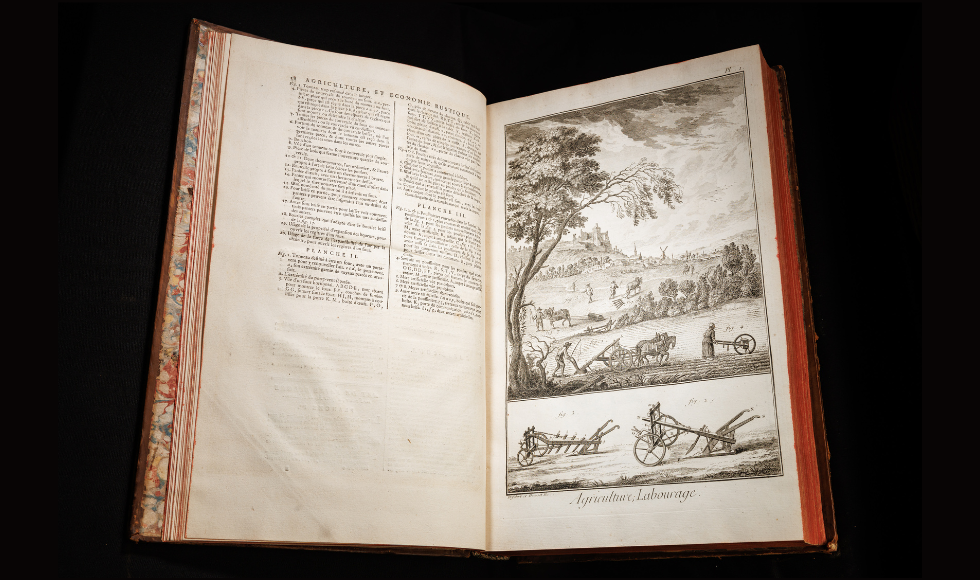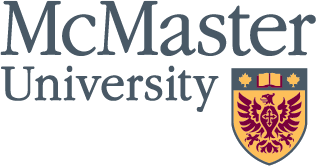One of the most significant intellectual works of the 18th century now at McMaster

A volume of the Encyclopédie, ou dictionnaire raisonné des sciences, des arts et des métiers at McMaster University Libraires. The set consists of 17 volumes of text and 11 plates engraved with detailed illustrations.
The William Ready Division of Archives and Research Collections has acquired a complete first-edition set of one of the most important publications to emerge from 18th century Europe.
The Encyclopédie, ou dictionnaire raisonné des sciences, des arts et des métiers, edited by Denis Diderot with help from Jean le Rond d’Alembert, has been described as the supreme work of the French Enlightenment.
Myron Groover, archives and rare books librarian at McMaster University Libraries, says the set details vast knowledge of the inner workings of every conceivable industry, handicraft, and means of manufacturing from its time.
“The contributors wanted to give a panoramic view of the world around them and to record everything — all of the ideas and debates that people were having, as well as everything known about the history of the world,” he said. “It is one of the most valuable sources that we have for the history of industry, engineering, architecture, construction, and the actual techniques that supported people’s lives in the 18th century. We owe a huge amount of our knowledge of this period to this set of books and illustrations.”
Published in Paris from 1751-1772, the final production consisted of 28 folio volumes with more than 71,000 articles and almost 3,000 illustrations. It was written by a company of authors at the forefront of Enlightenment thinking — the so-called Encyclopédistes — including Rousseau, Voltaire, Montesquieu, and Diderot himself.
Many of the articles were written directly by experts in relevant fields, offering firsthand knowledge from professionals at the turning point of the Industrial Revolution. Whether discussing architecture, philosophy, brewing, or textile production, the contributors frequently brought their lived experiences to their writing.
“The technical illustrations of the different trades are an incredibly important historical source,” said Ruth-Ellen St. Onge, distinctive collections cataloguing librarian at McMaster University Libraries. “They also show the role of women, not just in industries that were traditionally associated with them, but across a wide range of trades. By looking at the illustrations, you see that women were active contributors to trades and industries at that time, which to me, is very powerful.”
The Encyclopédie did more than document trades and industries; it also challenged social and political norms of the 18th century.
The books contained subject matter that the French establishment viewed as radical, leading to a loss of publishing permission less than halfway through the production process. To continue producing volumes, the publishers began to misrepresent the place of printing.
Despite publishing hurdles and high costs associated with printing large volumes at scale, the books were very successful and made a large profit.
Centuries after its original publication, the Encyclopédie now complements the university libraries’ existing collection of 18th century rare books.
The set still holds tremendous value today for teaching, learning, and research. William Hanley, professor of French in McMaster’s Faculty of Humanities, says that students and faculty across a variety of disciplines will benefit from its use.
“Diderot’s extraordinary enterprise, which is an elegant testimony to his courage, provides an invaluable insight into numerous aspects of the French Enlightenment,” he said.
The volumes acquired by McMaster are bound in matching covers from the period of their production, a rare feature for a set of this size and age.
When the books arrived at McMaster, their covers showed significant structural damage and signs of environmental degradation, which had caused the spines to weaken and the leather to turn brittle and powdery. Bronwen Glover, archives and book conservator at McMaster University Libraries, is currently working to repair and conserve each volume so that the books are fit to handle while retaining as much of the original binding as possible — an intricate undertaking that will permit the books to continue being used and enjoyed well into the future.
The conservation process is also bringing new information to light about the books’ history. Preliminary work has already revealed traces of earlier manuscript texts, unseen for over 200 years, which were recycled into the books’ covers to strengthen them. Analysis of these texts may reveal further clues as work continues.


